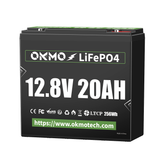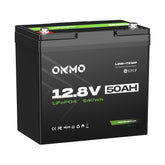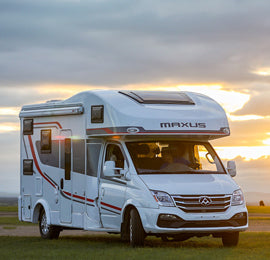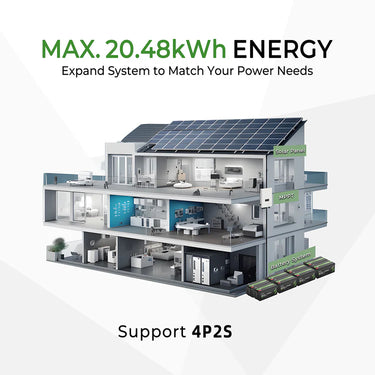Large RV Energy Battery Selection and System Integration Guide

With the growing demand for RV travel, efficient, safe, and long-lasting energy systems have become a core concern for users. Lithium Iron Phosphate (LiFePO4) batteries have emerged as the preferred solution for RV power supply and energy storage due to their comprehensive performance advantages. This article provides a detailed analysis of LiFePO4 battery applications, covering power requirements, energy storage design, battery selection, and system assembly.
1. Core Power and Energy Storage Requirements for RVs
1.1 High Capacity and Long Endurance
RVs must support multiple electrical devices (e.g., refrigerators, air conditioners, lighting), with daily energy consumption typically ranging between 5–15 kWh. For example, a 1-horsepower air conditioner running for 5 hours consumes approximately 5 kWh, while additional devices like refrigerators and LED lights require 1–3 kWh. LiFePO4 batteries offer a Depth of Discharge (DoD) of 80–90%, far exceeding the 50% DoD of lead-acid batteries. This means double the usable energy at the same capacity, significantly reducing battery size and weight.
1.2 Fast Charging/Discharging and Compatibility
RVs often rely on solar power, grid electricity, or onboard generators for charging. LiFePO4 batteries feature a wide voltage acceptance range (10V–14.6V), enabling seamless integration with solar systems. When paired with an MPPT controller, a 400W solar panel can fully charge a 200Ah battery in 5–6 hours. Advanced LiFePO4 batteries with 4C fast-charging technology (e.g., CATL’s "Shenxing Battery") can achieve 400 km of range with a 10-minute charge, drastically reducing downtime.
1.3 Extreme Environmental Adaptability
RVs may face temperature fluctuations from -20°C to 50°C. LiFePO4 batteries operate stably within -20°C to 60°C, with high-end models featuring built-in self-heating for -30°C cold starts. In contrast, lead-acid batteries lose up to 30% capacity in low temperatures.
1.4 Safety and Longevity
LiFePO4 batteries excel in thermal stability, showing no combustion during nail penetration tests and surface temperatures of only 200–400°C, significantly lower than the 500°C+ combustion risk of NMC batteries. Their cycle life reaches 3,000–5,000 cycles (vs. 300–500 cycles for lead-acid), with a lifespan of 8–15 years.
2. LiFePO4 Battery Selection and Performance Comparison
2.1 Cell Types
-
Pouch Cells: Lightweight and compact (30% lighter than aluminum/steel cases), ideal for space-constrained RVs.
-
Prismatic Aluminum Cells: Structurally stable, suitable for large-capacity systems (400Ah+).
-
Cylindrical Cells: Low cost but poor volumetric efficiency, gradually being phased out.
2.2 Key Performance Metrics
| Parameter | LiFePO4 Batteries | Lead-Acid Batteries |
|---|---|---|
| Energy Density (Wh/kg) | 140–160 (up to 180) | 30–50 |
| Cycle Life | 3,000–5,000 cycles | 300–500 cycles |
| Weight (100Ah) | 31 lbs | 60–70 lbs |
| Charging Efficiency | 99% | 85% |

3. LiFePO4 Battery Assembly and System Integration
3.1 Capacity Calculation
For a daily consumption of 7.2 kWh:
-
Total Capacity Required = 7.2 kWh ÷ 12V × 1.2 (buffer factor) = 720Ah
-
Recommended Configuration: 4 × 200Ah LiFePO4 batteries in parallel (800Ah total), supporting 3–5 days of off-grid use.
3.2 Assembly Steps
-
Cell Matching: Select cells with consistent internal resistance and voltage (≤0.01V deviation).
-
Structural Fixation: Secure cells using nylon straps or anti-vibration brackets to prevent leaks.
-
BMS Integration: Install a Battery Management System (BMS) with multi-layer protection (overcharge/discharge, temperature monitoring, short-circuit prevention).
-
Wiring and Insulation: Use silicone-coated wires and apply insulating gel to prevent oxidation.
3.3 Power System Design
-
Solar Integration: Pair with an MPPT controller (e.g., Renogy Rover 40A), sizing solar panels to 1.5× daily consumption (e.g., 1,500W panels for 10 kWh/day).
-
Hybrid Charging: Combine grid, generator, and solar inputs using a hybrid inverter (e.g., Victron MultiPlus-II) to power high-demand devices (microwaves, AC units).
4. Market Solutions and Innovations
4.1 Modular Designs
Brands like OKMO offer stackable modules, allowing incremental expansion (e.g., OKMO 12v 200Ah to 800Ah) without system replacement.
4.2 Fast-Charging and High Voltage
-
4C Ultra-Fast Charging: CATL’s Shenxing Battery adds only 5% cost for 10-minute 400 km charging.
-
800V High-Voltage Systems: Zeekr’s "Golden Brick" battery achieves 500kW charging and 83.7% volumetric efficiency.
4.3 Smart Monitoring
Real-time tracking via Bluetooth/Wi-Fi BMS, including state of charge (SOC), temperature, and health diagnostics.
5. Maintenance and Cost Analysis
5.1 Maintenance
-
Avoid discharging below 10%; store at 50% charge for long-term storage.
-
Inspect terminals every 6 months and apply dielectric grease.
5.2 Cost Comparison
| Item | LiFePO4 (800Ah) | Lead-Acid (1,600Ah) |
|---|---|---|
| Initial Cost | 4,000–6,000 | 2,000–3,000 |
| 10-Year Total Cost | 4,000–6,000 | 8,000–12,000 |
| Weight | 248 lbs | 960 lbs |
Conclusion
LiFePO4 batteries, with their high efficiency, longevity, and safety, have set the standard for RV battery energy systems. Users should select modular or high-voltage solutions based on energy needs, space constraints, and budget. With advancements in 4C charging and smart BMS, RV energy management will become even more reliable and user-friendly.









